SN 0201-93
基本信息
标准号: SN 0201-93
中文名称:出口水产品中多氯联苯残留量检验方法
标准类别:商检行业标准(SN)
标准状态:现行
出版语种:简体中文
下载格式:.zip .pdf
下载大小:2425277
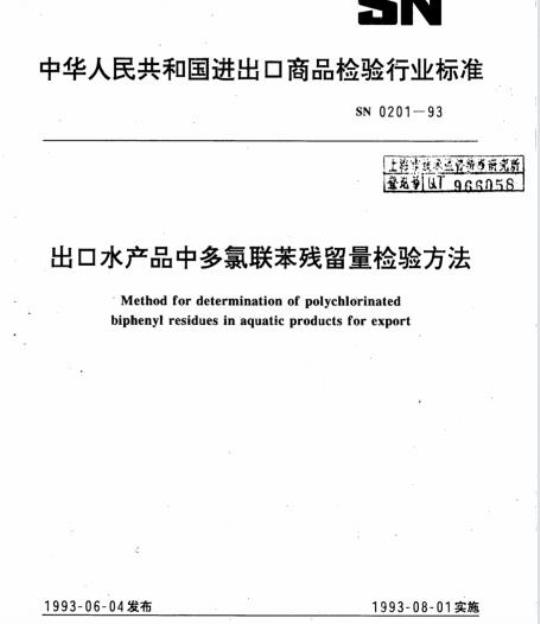
标准分类号
关联标准
出版信息
相关单位信息
标准简介
SN 0201-93.Method for determination of polychlorinated biphenyl residues in aquatic products for export.
1主题内容与适用范围
SN 0201规定了使用大口径(0.53mm)毛细管柱和配有电子俘获检测器的气相色谱仪检测特定的六个单一的氯联苯作为水产品中多氣联苯残留量的检验方法及抽样、制样方法。
SN 0201适用于出口鱼、虾、贝中多氯联苯残留量的检验,同时也适用于猪肉中多氯联苯残留量的检验。
2抽样和制样
2.1 检验批
以不超过10000箱为--检验批,同一检验批的商品应具有相同的特征,如包装、标记、产地、规格和等级等。
2.2抽样数量
批 量(箱) 最低抽样数(箱)
冷冻品 活品、盐藏品
150及以下 90及以下 3
151~3200 91~ 500 8
3201~10000 501~1200 13
1201~10000 20
2.3抽样方法
按2.2规定的抽样箱数随机抽取,逐件开启。每箱至少取500g作为原始样品,原始样品总量不得少于2kg。加封后,标明标记,及时送实验室。
2.4 试样制备
将抽取的样品去鳞、去骨后,将所有可食部分充分搅碎和混匀,用四分法缩分出1 kg,然后一分为二份,分别装入洁净容器内,作为试样。密封,并标明标记。
2.5 试样保存
将试样于一18C冷冻保存。
注:①在抽样和制样的操作过程中必须防止样品受到污染或发生残留物含量的变化。
②猪肉样品的抽取和制备按SN0195<出口肉及肉制品中2,4-滴残留量检验方法)中规定的抽样.制样方法进行。
1主题内容与适用范围
SN 0201规定了使用大口径(0.53mm)毛细管柱和配有电子俘获检测器的气相色谱仪检测特定的六个单一的氯联苯作为水产品中多氣联苯残留量的检验方法及抽样、制样方法。
SN 0201适用于出口鱼、虾、贝中多氯联苯残留量的检验,同时也适用于猪肉中多氯联苯残留量的检验。
2抽样和制样
2.1 检验批
以不超过10000箱为--检验批,同一检验批的商品应具有相同的特征,如包装、标记、产地、规格和等级等。
2.2抽样数量
批 量(箱) 最低抽样数(箱)
冷冻品 活品、盐藏品
150及以下 90及以下 3
151~3200 91~ 500 8
3201~10000 501~1200 13
1201~10000 20
2.3抽样方法
按2.2规定的抽样箱数随机抽取,逐件开启。每箱至少取500g作为原始样品,原始样品总量不得少于2kg。加封后,标明标记,及时送实验室。
2.4 试样制备
将抽取的样品去鳞、去骨后,将所有可食部分充分搅碎和混匀,用四分法缩分出1 kg,然后一分为二份,分别装入洁净容器内,作为试样。密封,并标明标记。
2.5 试样保存
将试样于一18C冷冻保存。
注:①在抽样和制样的操作过程中必须防止样品受到污染或发生残留物含量的变化。
②猪肉样品的抽取和制备按SN0195<出口肉及肉制品中2,4-滴残留量检验方法)中规定的抽样.制样方法进行。
标准图片预览
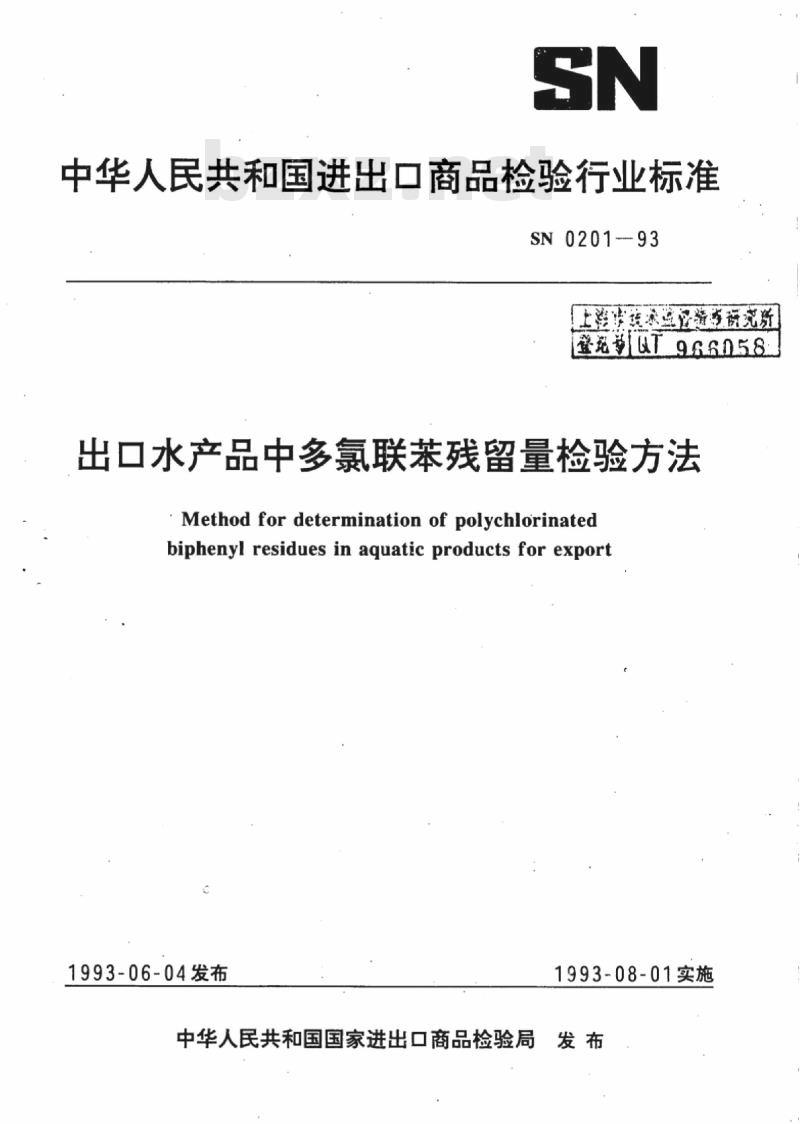
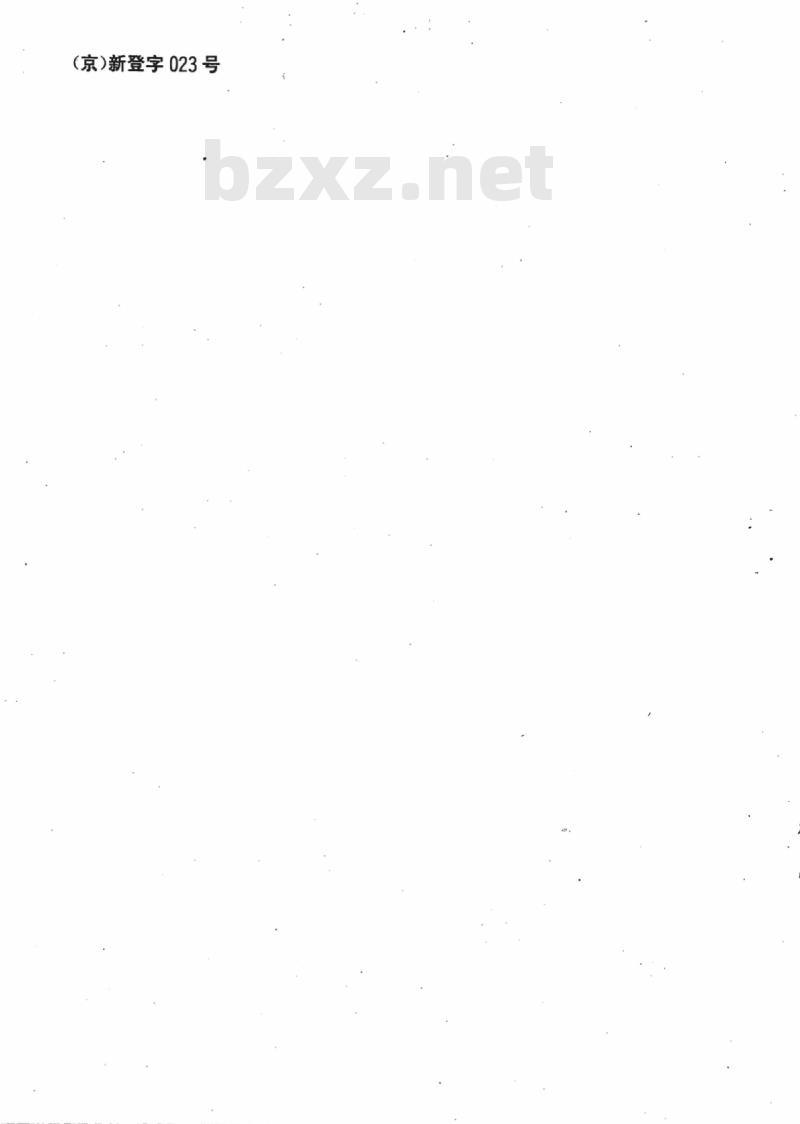
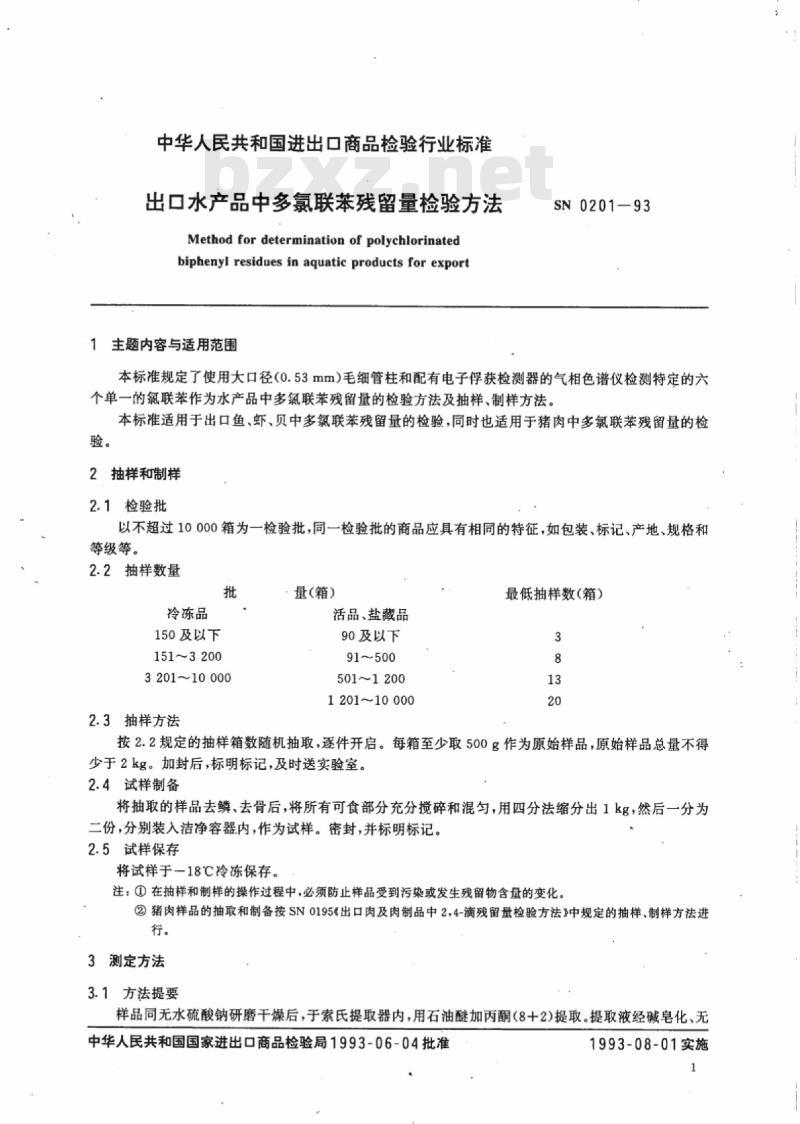
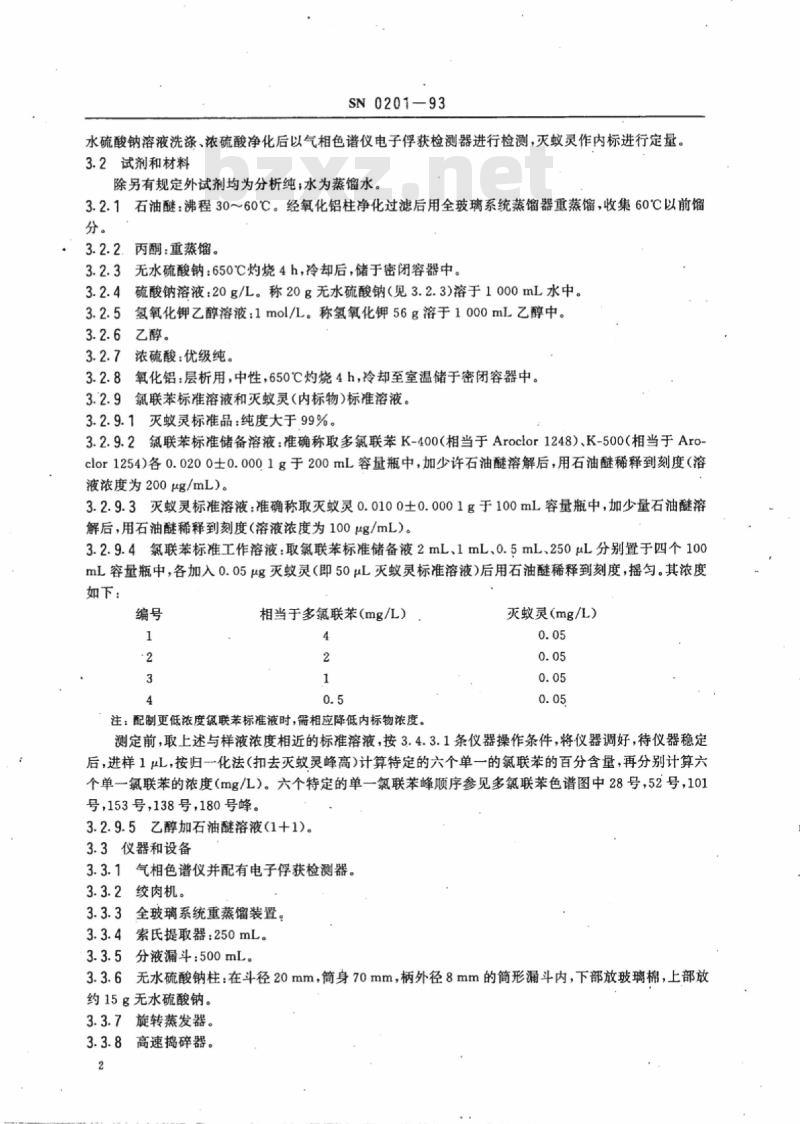
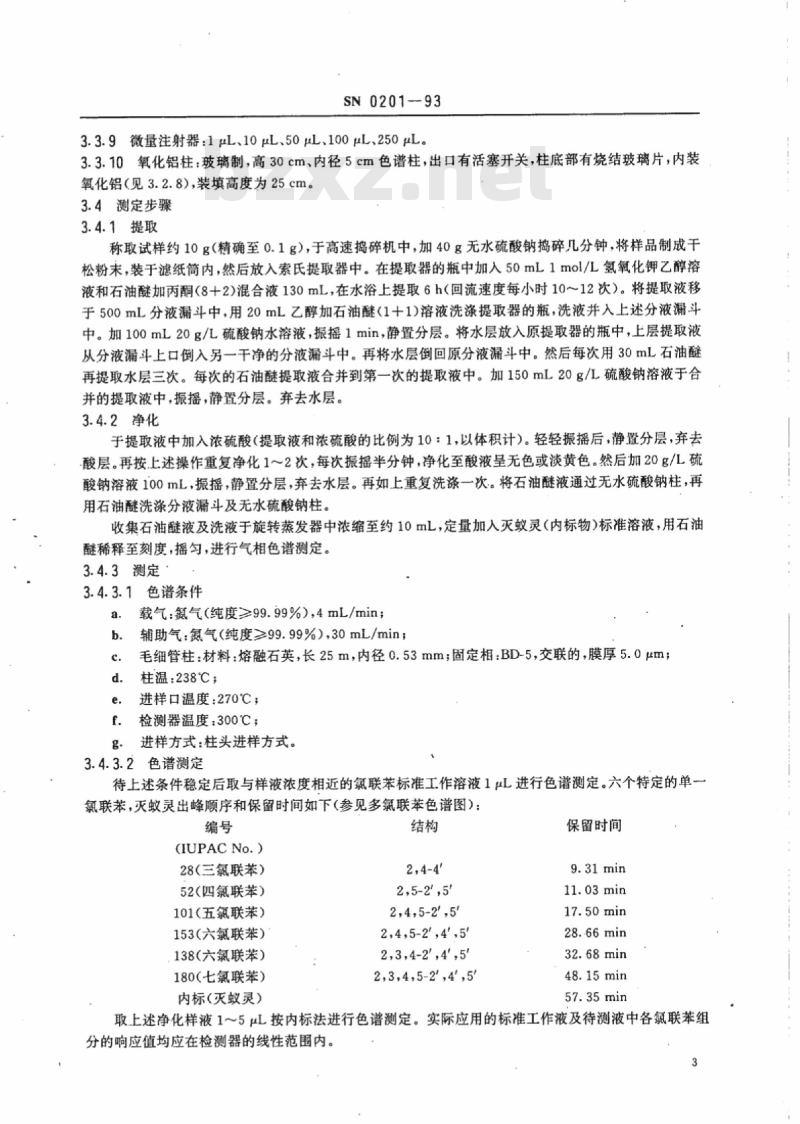
标准内容
中华人民共和国进出口商品检验行业标准SN0201--93
上技家监经资发研究所
登话号47966058
出口水产品中多氯联苯残留量检验方法: Method for determination of polychlorinatedbiphenyl residues in aquatic products for export1993-06-04发布
中华人民共和国国家进出口商品检验局1993-08-01实施
(京)新登字023号
中华人民共和国进出口商品检验行业标准出口水产品中多氯联苯残留量检验方法Method for determination of polychlorinatedbiphenyl residues in aquatic products for export1主题内容与适用范围
SN0201—93
本标准规定了使用大口径(0.53mm)毛细管柱和配有电子俘获检测器的气相色谱仪检测特定的六个单一的氯联苯作为水产品中多氮联苯残留量的检验方法及抽样、制样方法。本标准适用于出口鱼、虾、贝中多氯联苯残留量的检验,同时也适用于猪肉中多氯联苯残留量的检验。
2抽样和制样
2.1检验批
以不超过10000箱为一检验批,同一检验批的商品应具有相同的特征,如包装、标记、产地、规格和等级等。
2.2抽样数量
冷冻品
150及以下
151~3200
3201~10000
2.3抽样方法
量(箱)
活品、盐藏品
90及以下
501~1200
1201~10000
最低抽样数(箱)
按2.2规定的抽样箱数随机抽取,逐件开启。每箱至少取500g作为原始样品,原始样品总量不得少于2kg。加封后,标明标记,及时送实验室。2.4试样制备
将抽取的样品去鳞、去骨后,将所有可食部分充分搅碎和混匀,用四分法缩分出1kg,然后一分为二份,分别装入洁净容器内,作为试样。密封,并标明标记。2.5试样保存
将试样于-18℃冷冻保存。
注:①在抽样和制样的操作过程中,必须防止样品受到污染或发生残留物含量的变化。②猪肉样品的抽取和制备按SN0195出口肉及肉制品中2,4-滴残留量检验方法》中规定的抽样、制样方法进行。
3测定方法
3.1方法提要
样品同无水硫酸钠研磨干燥后,于索氏提取器内,用石油醚加丙酮(8十2)提取。提取液经碱皂化、无中华人民共和国国家进出口商品检验局1993-06-04批准1993-08-01实施
SN0201-93
水硫酸钠溶液洗涤、浓硫酸净化后以气相色谱仪电子俘获检测器进行检测,灭蚁灵作内标进行定量。3.2试剂和材料
除另有规定外试剂均为分析纯;水为蒸馏水。3.2.1石油醚:沸程30~60℃。经氧化铝柱净化过滤后用全玻璃系统蒸馏器重蒸馏,收集60℃以前馏分。
3.2.2.丙酮:重蒸馅。
3.2.3无水硫酸钠:650℃灼烧4h,冷却后,储于密闭容器中。3.2.4硫酸钠溶液:20g/L。称20g无水硫酸钠(见3.2.3)溶于1000mL水中。3.2.5氢氧化钾乙醇溶液:1mol/L。称氢氧化钾56g溶于1000mL乙醇中。3.2.6乙醇。
3.2.7浓硫酸:优级纯。
3.2.8氧化铝:层析用,中性,650℃灼烧4h,冷却至室温储于密闭容器中。3.2.9氯联苯标准溶液和灭蚁灵(内标物)标准溶液。3.2.9.1灭蚁灵标准品:纯度大于99%。3.2.9.2氯联苯标准储备溶液:准确称取多氯联苯K-400(相当于Aroclor1248)、K-500(相当于Aro-clor1254)各0.0200士0.0001g于200mL容量瓶中,加少许石油溶解后,用石油醚稀释到刻度(溶液浓度为200μg/mL)。
3.2.9.3灭蚁灵标准溶液:准确称取灭蚁灵0.0100土0.0001g于100mL容量瓶中,加少量石油醚溶解后,用石油醚稀释到刻度(溶液浓度为100μg/mL)。3.2.9.4氯联苯标准工作溶液:取氯联苯标准储备液2mL、1mL、0.5mL、250μL分别置于四个100mL容量瓶中,各加入0.05μg灭蚁灵(即50μL灭蚁灵标准溶液)后用石油醚稀释到刻度,摇匀。其浓度如下:
相当于多氟联苯(mg/L)
注:配制更低浓度氮联苯标准液时,需相应降低内标物浓度。灭蚁灵(mg/L)
测定前,取上述与样液浓度相近的标准溶液,按3.4.3.1条仪器操作条件,将仪器调好,待仪器稳定后,进样1μL,按归一化法(扣去灭蚁灵峰高)计算特定的六个单一的氯联苯的百分含量,再分别计算六个单一氯联苯的浓度(mg/L)。六个特定的单一氯联苯峰顺序参见多氟联苯色谱图中28号,52号,101号,153号,138号,180号峰。
3.2.9.5乙醇加石油醚溶液(1+1)。3.3仪器和设备
3.3.1气相色谱仪并配有电子俘获检测器。3.3.2绞肉机。
3.3.3全玻璃系统重蒸馏装置。
3.3.4索氏提取器:250mL。
3.3.5分液漏斗:500mL。
3.3.6无水硫酸钠柱:在斗径20mm,简身70mm,柄外径8mm的简形漏斗内,下部放玻璃棉,上部放约15g无水硫酸钠。
3.3.7旋转蒸发器。
3.3.8高速捣碎器。
SN0201--93
3.3.9微量注射器:1μL、10μL、50μL、100μL、250μL。3.3.10氧化铝柱:玻璃制,高30cm、内径5cm色谱柱,出口有活塞开关,柱底部有烧结玻璃片,内装氧化铝(见3.2.8),装填高度为25cm。3.4测定步骤
3.4.1提取
称取试样约10g(精确至0.1g),于高速捣碎机中,加40g无水硫酸钠捣碎几分钟,将样品制成干松粉末,装于滤纸筒内,然后放入索氏提取器中。在提取器的瓶中加入50mL1mol/L氢氧化钾乙醇溶液和石油醛加丙酮(8+2)混合液130mL,在水浴上提取6h(回流速度每小时10~12次)。将提取液移于500mL分液漏斗中.用20mL乙醇加石油醚(1十1)溶液洗涤提取器的瓶,洗液并入上述分液漏斗中。加100mL20g/L硫酸钠水溶液,振摇1min,静置分层。将水层放入原提取器的瓶中,上层提取液从分液漏斗上口倒入另一干净的分液漏斗中。再将水层倒回原分液漏斗中。然后每次用30mL石油醚再提取水层三次。每次的石油醚提取液合并到第一次的提取液中。加150mL20g/L硫酸钠溶液于合并的提取液中,振摇,静置分层。弃去水层。3.4.2净化
于提取液中加入浓硫酸(提取液和浓硫酸的比例为10:1,以体积计)。轻轻振摇后,静置分层,弃去酸层。再按上述操作重复净化12次,每次振摇半分钟,净化至酸液呈无色或淡黄色。然后加20g/L硫酸钠溶液100mL.振摇,静置分层,弃去水层。再如上重复洗涤一次。将石油醚液通过无水硫酸钠柱,再用石油醚洗涤分液漏斗及无水硫酸钠柱。收集石油液及洗液于旋转蒸发器中浓缩至约10mL,定量加入灭蚁灵(内标物)标准溶液,用石油醚稀释至刻度,摇匀,进行气相色谱测定。3.4.3测定
3.4.3.1色谱条件
载气:氮气(纯度≥99.99%),4mL/min;辅助气:氮气(纯度≥99.99%),30mL/min;毛细管柱:材料:熔融石英,长25m,内径0.53mm固定相:BD-5,交联的,膜厚5.0μm;柱温:238℃:
进样口温度:270℃;
检测器温度:300℃:
进样方式:柱头进样方式。
3.4.3.2色谱测定
待上述条件稳定后取与样液浓度相近的氯联苯标准工作溶液1L进行色谱测定。六个特定的单氯联苯,灭蚁灵出峰顺序和保留时间如下(参见多氯联苯色谱图):编号
(IUPACNo.)
28(三氧联苯)
52(四氯联苯)
101(五氟联苯)
153(六氯联苯)
138(六氯联苯)
180(七氯联苯)
内标(灭蚁灵)
2,4-4
2,52',5
2,4,5-2,5
2,4,5-2”,4',5
2,3,4-2\,4',5'
2,3,4,5-2',4',5
保留时间
28.-66minWww.bzxZ.net
取上述净化样液1~5L按内标法进行色谱测定。实际应用的标准工作液及待测液中各氮联苯组分的响应值均应在检测器的线性范围内。3
3.4.4空白试验
101号
SN0201-93
138号
153号
多氯联苯色谱图
除不加试样外,按上述条件及步骤进行空白试验。3.4.5结果的计算和表述
180号
《灭蚊灵)
应用数据处理系统适当程序计算六个特定的单一氯联苯残留量,或按下列公式分别进行计算。h·hi.c,.m
h.h,.cis.m
式中:X
试样中氯联苯残留量,mg/kg;
样液中氯联苯组分峰高,mm;
标准工作液中氯联苯组分峰高,mm:h
一标准工作液中内标物峰高,mm:一样液中内标物峰高,mm;
-标准工作液中氯联苯浓度,ng/μL;一标准工作液中内标物浓度,ng/μL;样液中加入内标物的量,g;
一称取样品量,g。
注:计算结果需扣除空白值。
本方法的测定结果分别按六个特定的单一氟联苯实际检测含量(mg/kg)报出。4测定低限、回收率
4.1测定低限
本方法测定低限为0.005mg/kg。4.2回收率
SN0201-93
回收率的实验数据:
28号三氯联苯(2,4-4')浓度在0.023~0.235mg/kg范围,回收率为89.3%~101.3%。52号四氯联苯(2,5-2\,5\)浓度在0.064~0.370mg/kg范围,回收率为85.9%~101.1%。101号五氟联苯(2,4,5-2',5')浓度在0.068~0.434mg/kg范围,回收率为86.8%~110.4%。153号六氯联苯(2,4,5-2',4,5')浓度在0.023~0.174mg/kg范围,回收率为100%~117.8%。138号六氯联苯(2,3,4-2\,4,5')浓度在0.032~0.215mg/kg范围,回收率为90.6%~108.4%。180号七氯联苯(2,3,4,5-2\4,5\)浓度在0.009~0.0435mg/kg范围,回收率为100%~~114.0%。
附加说明:
本标准由中华人民共和国国家进出口商品检验局提出。本标准由中华人民共和国山东进出口商品检验局负责起草。本标准主要起草人刘学梯、刘淑贞、李戈。主要参考文献:
Quantitative Determination of Specified Chlorobiphenyls in Fish with Capillary Gas Chromatogra-phy and its Use for Monitoring and Tolerance Purpose,Inter. J.Environ.Anal. Chem.,Vol. 14,pp 147-157.
Professional Standard of the People's Republic of Chinafor Import and Export Commodity. inspectionSN0201-93
Method for determination of polychlorinatedbiphenyl residues in aquatic products for exportScope and field of applicationThis standard specifies the methods of sampling,sample preparation and determination of the sixspecified individual polychlorinated biphenyls as the polychlorinated biphenyl residues in aquatic prod-ucts for export by wide-bore capillary column(o. 53 mm)gas chromatography(GC)with electron cap-ture detector.
This standard is applicable to the determination of polychlorinated biphenyl residues in aquaticproducts,such as fish,prawn and shell fish for export,and also in pork for export.Sampling and sample preparation2
2.1Inspection lot
The quantity of an inspection lot should not be more than lo ooo packages.The characteristics of the cargo within the same inspection lot,such as packing,mark, origin,grade and specification,should be the same.2.2Quantity of sample taken
Number of packages in each
inspection lot
Frozen
≤150
1513200
3201~1000
2.3 Sampling procedure
Live,salted
91~500
5011200
1201~10000
Minimum number of
packages to be taken
A number of packages specified in 2. 2 are taken at random and opened one by one. The sampleweight taken as the primary sample from'each package should be at least 500 grams. The total weightof all primary samples should not be less than 2 kg,which shall be sealed,labeled and sent to laborato-ry in time.
2.4 Preparation of test sampleThe combined primary sample is scaled and deboned. The edible portion is blended and reduced byquartering to 1 kg. Then divided into two equal portions,each portion is placed in a clean container astest sample,which is sealed and labeled.2.5 Storage of sample
Approved by the State Administration ofImport and Export Commodity Inspection ofthe People's Republic of China on Jun. 4,1993+
Implemented from Aug.1,1993
SN0201-93
The test samples should be stored at -l8'℃.Note 1: In the course of sampling and sample preparation,precaution must be taken to avoid contamination or anyfactors which may cause the change of residue content.Note 2: The sampling and sample preparation of the pork should be carried out as that indicated in \Method for determination of 2,4-D residues in meat and meat products for export\,SN 0195.3 Method of determination
3.1Principle
After grinding and drying by blending with anhydrous sodium sulphate transfer the sample into aSoxhlet extractor ,and extract the chlorobiphenyls with petroleum ether-acetone(8+2). The extract issaponified with alkali and washed with sodium.sulphate solution and then cleaned up with concentrat.ed sulphuric acid. Determine the residues by GC with electron capture detector using Mirex as internalstandard.
3.2 Reagents and materials
Unless otherwise specified,all reagents shall be analytically pure, \water\means distilled water.3. 2.1 Petroleum ether:Distillation range 30—60'C after clean up by filtering through alumina col-umn,redistill the reagent in the all-glass apparatus ,and collect the fraction below 6o'C.3.2.2Acetone:Redistilled.
3.2.3 Anhydrous sodium suiphate:Ignite at 65o℃ for 4 h,and keep in a tightly closed container after cooling.
3.2.4 Sodium sulphate solution: 20 g/L. Weigh 20 g of anhydrous sodium sulphate (3. 2. 3)and dis-solve in 1 000 mL of water.
3. 2.5 Potassium hydroxide alcoholic solution:1 mol/L. Weigh 56 g of potassium hydroxide and dis-solve in 1 000 mL of alcohol.3.2.6Alcohol.
3.2.7 Concentrated sulphuric acid.G.R..3. 2. 8 Alumina:For chromatography,neutral,ignite at 650℃ for 4 h,and keep in a tightly 'closedcontainer after cooling to the room temperature.3. 2. 9 Chlorinated biphenyls standard solution and Mirex(internal standard)standard solution.3.2.9.1 Mirex standard.Purity>99%.3. 2. 9.2 Chlorinated biphenyls standard stock solution :Accurately weigh 0. 020 0±0. 000 1 g each ofpolychlorinated biphenyl K-400 (equivalent to Aroclor 1248)and K-500(equivalent to Aroclor 1254),place them in 200 mL volumetric flask ,add a small amount of petroleum ether to dissolve them and di-lute to mark (concentration being 200 μg/mL).3.2.9.3 Mirex standard solution:Accurately weigh 0. 010 0±0. 000 1 g of Mirex,transfer into a 100mL volumetric flask ,add a small amount of petroleum ether to dissolve them and dilute to mark (concentration being 1oo μg/nL).3.2.9.4 Chlorinated biphenyls standard working solution: Transfer 2 mL,l mL,0. 5 mL,and 250 μLof chlorinated biphenyls standard solution into four l00 mL volumetric flasks respectively. Add o. 05μg of Mirex (i.e. 50 μL of Mirex standard solution)to each flask,and dilute to mark with petroleumether. Their.concentrations are as follows.
小提示:此标准内容仅展示完整标准里的部分截取内容,若需要完整标准请到上方自行免费下载完整标准文档。
上技家监经资发研究所
登话号47966058
出口水产品中多氯联苯残留量检验方法: Method for determination of polychlorinatedbiphenyl residues in aquatic products for export1993-06-04发布
中华人民共和国国家进出口商品检验局1993-08-01实施
(京)新登字023号
中华人民共和国进出口商品检验行业标准出口水产品中多氯联苯残留量检验方法Method for determination of polychlorinatedbiphenyl residues in aquatic products for export1主题内容与适用范围
SN0201—93
本标准规定了使用大口径(0.53mm)毛细管柱和配有电子俘获检测器的气相色谱仪检测特定的六个单一的氯联苯作为水产品中多氮联苯残留量的检验方法及抽样、制样方法。本标准适用于出口鱼、虾、贝中多氯联苯残留量的检验,同时也适用于猪肉中多氯联苯残留量的检验。
2抽样和制样
2.1检验批
以不超过10000箱为一检验批,同一检验批的商品应具有相同的特征,如包装、标记、产地、规格和等级等。
2.2抽样数量
冷冻品
150及以下
151~3200
3201~10000
2.3抽样方法
量(箱)
活品、盐藏品
90及以下
501~1200
1201~10000
最低抽样数(箱)
按2.2规定的抽样箱数随机抽取,逐件开启。每箱至少取500g作为原始样品,原始样品总量不得少于2kg。加封后,标明标记,及时送实验室。2.4试样制备
将抽取的样品去鳞、去骨后,将所有可食部分充分搅碎和混匀,用四分法缩分出1kg,然后一分为二份,分别装入洁净容器内,作为试样。密封,并标明标记。2.5试样保存
将试样于-18℃冷冻保存。
注:①在抽样和制样的操作过程中,必须防止样品受到污染或发生残留物含量的变化。②猪肉样品的抽取和制备按SN0195出口肉及肉制品中2,4-滴残留量检验方法》中规定的抽样、制样方法进行。
3测定方法
3.1方法提要
样品同无水硫酸钠研磨干燥后,于索氏提取器内,用石油醚加丙酮(8十2)提取。提取液经碱皂化、无中华人民共和国国家进出口商品检验局1993-06-04批准1993-08-01实施
SN0201-93
水硫酸钠溶液洗涤、浓硫酸净化后以气相色谱仪电子俘获检测器进行检测,灭蚁灵作内标进行定量。3.2试剂和材料
除另有规定外试剂均为分析纯;水为蒸馏水。3.2.1石油醚:沸程30~60℃。经氧化铝柱净化过滤后用全玻璃系统蒸馏器重蒸馏,收集60℃以前馏分。
3.2.2.丙酮:重蒸馅。
3.2.3无水硫酸钠:650℃灼烧4h,冷却后,储于密闭容器中。3.2.4硫酸钠溶液:20g/L。称20g无水硫酸钠(见3.2.3)溶于1000mL水中。3.2.5氢氧化钾乙醇溶液:1mol/L。称氢氧化钾56g溶于1000mL乙醇中。3.2.6乙醇。
3.2.7浓硫酸:优级纯。
3.2.8氧化铝:层析用,中性,650℃灼烧4h,冷却至室温储于密闭容器中。3.2.9氯联苯标准溶液和灭蚁灵(内标物)标准溶液。3.2.9.1灭蚁灵标准品:纯度大于99%。3.2.9.2氯联苯标准储备溶液:准确称取多氯联苯K-400(相当于Aroclor1248)、K-500(相当于Aro-clor1254)各0.0200士0.0001g于200mL容量瓶中,加少许石油溶解后,用石油醚稀释到刻度(溶液浓度为200μg/mL)。
3.2.9.3灭蚁灵标准溶液:准确称取灭蚁灵0.0100土0.0001g于100mL容量瓶中,加少量石油醚溶解后,用石油醚稀释到刻度(溶液浓度为100μg/mL)。3.2.9.4氯联苯标准工作溶液:取氯联苯标准储备液2mL、1mL、0.5mL、250μL分别置于四个100mL容量瓶中,各加入0.05μg灭蚁灵(即50μL灭蚁灵标准溶液)后用石油醚稀释到刻度,摇匀。其浓度如下:
相当于多氟联苯(mg/L)
注:配制更低浓度氮联苯标准液时,需相应降低内标物浓度。灭蚁灵(mg/L)
测定前,取上述与样液浓度相近的标准溶液,按3.4.3.1条仪器操作条件,将仪器调好,待仪器稳定后,进样1μL,按归一化法(扣去灭蚁灵峰高)计算特定的六个单一的氯联苯的百分含量,再分别计算六个单一氯联苯的浓度(mg/L)。六个特定的单一氯联苯峰顺序参见多氟联苯色谱图中28号,52号,101号,153号,138号,180号峰。
3.2.9.5乙醇加石油醚溶液(1+1)。3.3仪器和设备
3.3.1气相色谱仪并配有电子俘获检测器。3.3.2绞肉机。
3.3.3全玻璃系统重蒸馏装置。
3.3.4索氏提取器:250mL。
3.3.5分液漏斗:500mL。
3.3.6无水硫酸钠柱:在斗径20mm,简身70mm,柄外径8mm的简形漏斗内,下部放玻璃棉,上部放约15g无水硫酸钠。
3.3.7旋转蒸发器。
3.3.8高速捣碎器。
SN0201--93
3.3.9微量注射器:1μL、10μL、50μL、100μL、250μL。3.3.10氧化铝柱:玻璃制,高30cm、内径5cm色谱柱,出口有活塞开关,柱底部有烧结玻璃片,内装氧化铝(见3.2.8),装填高度为25cm。3.4测定步骤
3.4.1提取
称取试样约10g(精确至0.1g),于高速捣碎机中,加40g无水硫酸钠捣碎几分钟,将样品制成干松粉末,装于滤纸筒内,然后放入索氏提取器中。在提取器的瓶中加入50mL1mol/L氢氧化钾乙醇溶液和石油醛加丙酮(8+2)混合液130mL,在水浴上提取6h(回流速度每小时10~12次)。将提取液移于500mL分液漏斗中.用20mL乙醇加石油醚(1十1)溶液洗涤提取器的瓶,洗液并入上述分液漏斗中。加100mL20g/L硫酸钠水溶液,振摇1min,静置分层。将水层放入原提取器的瓶中,上层提取液从分液漏斗上口倒入另一干净的分液漏斗中。再将水层倒回原分液漏斗中。然后每次用30mL石油醚再提取水层三次。每次的石油醚提取液合并到第一次的提取液中。加150mL20g/L硫酸钠溶液于合并的提取液中,振摇,静置分层。弃去水层。3.4.2净化
于提取液中加入浓硫酸(提取液和浓硫酸的比例为10:1,以体积计)。轻轻振摇后,静置分层,弃去酸层。再按上述操作重复净化12次,每次振摇半分钟,净化至酸液呈无色或淡黄色。然后加20g/L硫酸钠溶液100mL.振摇,静置分层,弃去水层。再如上重复洗涤一次。将石油醚液通过无水硫酸钠柱,再用石油醚洗涤分液漏斗及无水硫酸钠柱。收集石油液及洗液于旋转蒸发器中浓缩至约10mL,定量加入灭蚁灵(内标物)标准溶液,用石油醚稀释至刻度,摇匀,进行气相色谱测定。3.4.3测定
3.4.3.1色谱条件
载气:氮气(纯度≥99.99%),4mL/min;辅助气:氮气(纯度≥99.99%),30mL/min;毛细管柱:材料:熔融石英,长25m,内径0.53mm固定相:BD-5,交联的,膜厚5.0μm;柱温:238℃:
进样口温度:270℃;
检测器温度:300℃:
进样方式:柱头进样方式。
3.4.3.2色谱测定
待上述条件稳定后取与样液浓度相近的氯联苯标准工作溶液1L进行色谱测定。六个特定的单氯联苯,灭蚁灵出峰顺序和保留时间如下(参见多氯联苯色谱图):编号
(IUPACNo.)
28(三氧联苯)
52(四氯联苯)
101(五氟联苯)
153(六氯联苯)
138(六氯联苯)
180(七氯联苯)
内标(灭蚁灵)
2,4-4
2,52',5
2,4,5-2,5
2,4,5-2”,4',5
2,3,4-2\,4',5'
2,3,4,5-2',4',5
保留时间
28.-66minWww.bzxZ.net
取上述净化样液1~5L按内标法进行色谱测定。实际应用的标准工作液及待测液中各氮联苯组分的响应值均应在检测器的线性范围内。3
3.4.4空白试验
101号
SN0201-93
138号
153号
多氯联苯色谱图
除不加试样外,按上述条件及步骤进行空白试验。3.4.5结果的计算和表述
180号
《灭蚊灵)
应用数据处理系统适当程序计算六个特定的单一氯联苯残留量,或按下列公式分别进行计算。h·hi.c,.m
h.h,.cis.m
式中:X
试样中氯联苯残留量,mg/kg;
样液中氯联苯组分峰高,mm;
标准工作液中氯联苯组分峰高,mm:h
一标准工作液中内标物峰高,mm:一样液中内标物峰高,mm;
-标准工作液中氯联苯浓度,ng/μL;一标准工作液中内标物浓度,ng/μL;样液中加入内标物的量,g;
一称取样品量,g。
注:计算结果需扣除空白值。
本方法的测定结果分别按六个特定的单一氟联苯实际检测含量(mg/kg)报出。4测定低限、回收率
4.1测定低限
本方法测定低限为0.005mg/kg。4.2回收率
SN0201-93
回收率的实验数据:
28号三氯联苯(2,4-4')浓度在0.023~0.235mg/kg范围,回收率为89.3%~101.3%。52号四氯联苯(2,5-2\,5\)浓度在0.064~0.370mg/kg范围,回收率为85.9%~101.1%。101号五氟联苯(2,4,5-2',5')浓度在0.068~0.434mg/kg范围,回收率为86.8%~110.4%。153号六氯联苯(2,4,5-2',4,5')浓度在0.023~0.174mg/kg范围,回收率为100%~117.8%。138号六氯联苯(2,3,4-2\,4,5')浓度在0.032~0.215mg/kg范围,回收率为90.6%~108.4%。180号七氯联苯(2,3,4,5-2\4,5\)浓度在0.009~0.0435mg/kg范围,回收率为100%~~114.0%。
附加说明:
本标准由中华人民共和国国家进出口商品检验局提出。本标准由中华人民共和国山东进出口商品检验局负责起草。本标准主要起草人刘学梯、刘淑贞、李戈。主要参考文献:
Quantitative Determination of Specified Chlorobiphenyls in Fish with Capillary Gas Chromatogra-phy and its Use for Monitoring and Tolerance Purpose,Inter. J.Environ.Anal. Chem.,Vol. 14,pp 147-157.
Professional Standard of the People's Republic of Chinafor Import and Export Commodity. inspectionSN0201-93
Method for determination of polychlorinatedbiphenyl residues in aquatic products for exportScope and field of applicationThis standard specifies the methods of sampling,sample preparation and determination of the sixspecified individual polychlorinated biphenyls as the polychlorinated biphenyl residues in aquatic prod-ucts for export by wide-bore capillary column(o. 53 mm)gas chromatography(GC)with electron cap-ture detector.
This standard is applicable to the determination of polychlorinated biphenyl residues in aquaticproducts,such as fish,prawn and shell fish for export,and also in pork for export.Sampling and sample preparation2
2.1Inspection lot
The quantity of an inspection lot should not be more than lo ooo packages.The characteristics of the cargo within the same inspection lot,such as packing,mark, origin,grade and specification,should be the same.2.2Quantity of sample taken
Number of packages in each
inspection lot
Frozen
≤150
1513200
3201~1000
2.3 Sampling procedure
Live,salted
91~500
5011200
1201~10000
Minimum number of
packages to be taken
A number of packages specified in 2. 2 are taken at random and opened one by one. The sampleweight taken as the primary sample from'each package should be at least 500 grams. The total weightof all primary samples should not be less than 2 kg,which shall be sealed,labeled and sent to laborato-ry in time.
2.4 Preparation of test sampleThe combined primary sample is scaled and deboned. The edible portion is blended and reduced byquartering to 1 kg. Then divided into two equal portions,each portion is placed in a clean container astest sample,which is sealed and labeled.2.5 Storage of sample
Approved by the State Administration ofImport and Export Commodity Inspection ofthe People's Republic of China on Jun. 4,1993+
Implemented from Aug.1,1993
SN0201-93
The test samples should be stored at -l8'℃.Note 1: In the course of sampling and sample preparation,precaution must be taken to avoid contamination or anyfactors which may cause the change of residue content.Note 2: The sampling and sample preparation of the pork should be carried out as that indicated in \Method for determination of 2,4-D residues in meat and meat products for export\,SN 0195.3 Method of determination
3.1Principle
After grinding and drying by blending with anhydrous sodium sulphate transfer the sample into aSoxhlet extractor ,and extract the chlorobiphenyls with petroleum ether-acetone(8+2). The extract issaponified with alkali and washed with sodium.sulphate solution and then cleaned up with concentrat.ed sulphuric acid. Determine the residues by GC with electron capture detector using Mirex as internalstandard.
3.2 Reagents and materials
Unless otherwise specified,all reagents shall be analytically pure, \water\means distilled water.3. 2.1 Petroleum ether:Distillation range 30—60'C after clean up by filtering through alumina col-umn,redistill the reagent in the all-glass apparatus ,and collect the fraction below 6o'C.3.2.2Acetone:Redistilled.
3.2.3 Anhydrous sodium suiphate:Ignite at 65o℃ for 4 h,and keep in a tightly closed container after cooling.
3.2.4 Sodium sulphate solution: 20 g/L. Weigh 20 g of anhydrous sodium sulphate (3. 2. 3)and dis-solve in 1 000 mL of water.
3. 2.5 Potassium hydroxide alcoholic solution:1 mol/L. Weigh 56 g of potassium hydroxide and dis-solve in 1 000 mL of alcohol.3.2.6Alcohol.
3.2.7 Concentrated sulphuric acid.G.R..3. 2. 8 Alumina:For chromatography,neutral,ignite at 650℃ for 4 h,and keep in a tightly 'closedcontainer after cooling to the room temperature.3. 2. 9 Chlorinated biphenyls standard solution and Mirex(internal standard)standard solution.3.2.9.1 Mirex standard.Purity>99%.3. 2. 9.2 Chlorinated biphenyls standard stock solution :Accurately weigh 0. 020 0±0. 000 1 g each ofpolychlorinated biphenyl K-400 (equivalent to Aroclor 1248)and K-500(equivalent to Aroclor 1254),place them in 200 mL volumetric flask ,add a small amount of petroleum ether to dissolve them and di-lute to mark (concentration being 200 μg/mL).3.2.9.3 Mirex standard solution:Accurately weigh 0. 010 0±0. 000 1 g of Mirex,transfer into a 100mL volumetric flask ,add a small amount of petroleum ether to dissolve them and dilute to mark (concentration being 1oo μg/nL).3.2.9.4 Chlorinated biphenyls standard working solution: Transfer 2 mL,l mL,0. 5 mL,and 250 μLof chlorinated biphenyls standard solution into four l00 mL volumetric flasks respectively. Add o. 05μg of Mirex (i.e. 50 μL of Mirex standard solution)to each flask,and dilute to mark with petroleumether. Their.concentrations are as follows.
小提示:此标准内容仅展示完整标准里的部分截取内容,若需要完整标准请到上方自行免费下载完整标准文档。